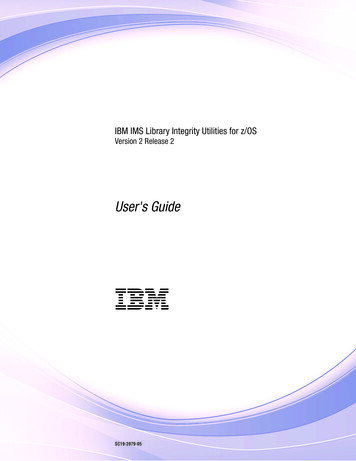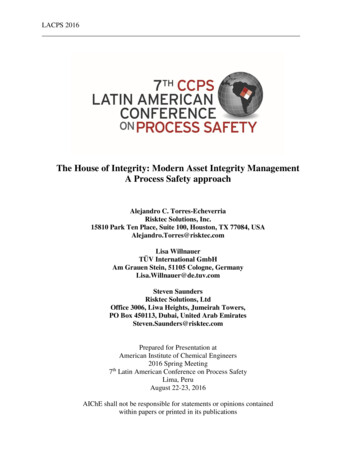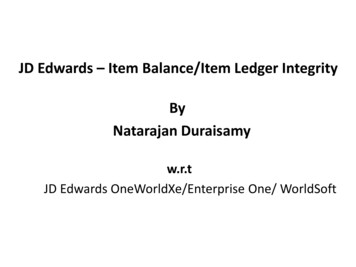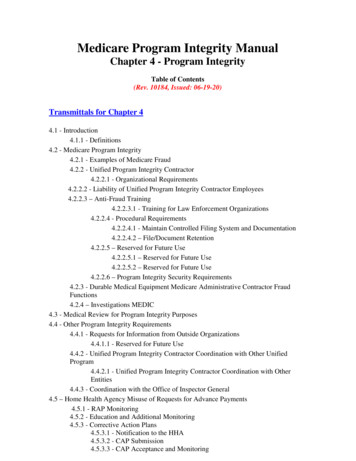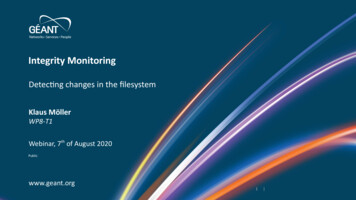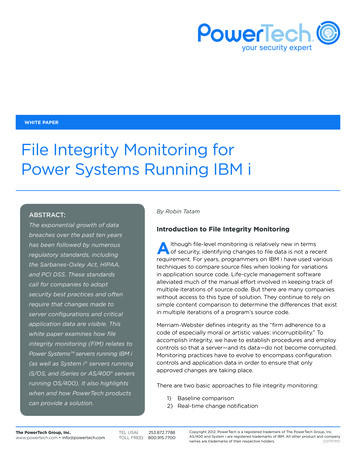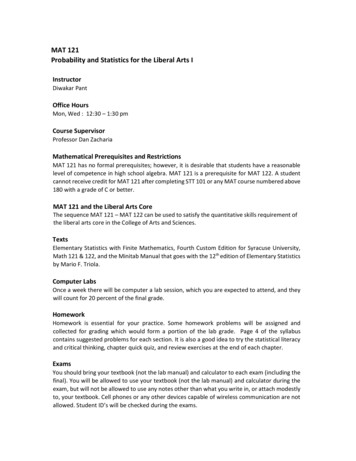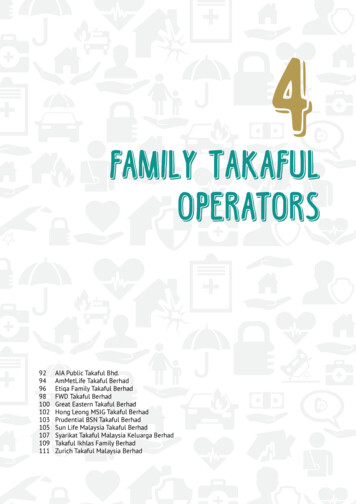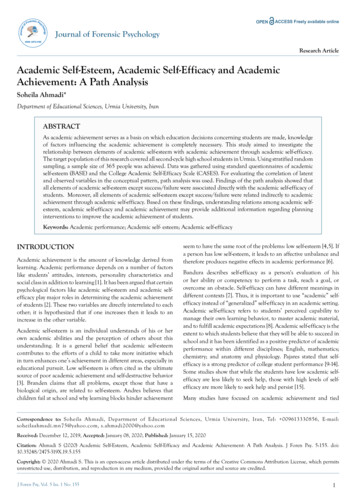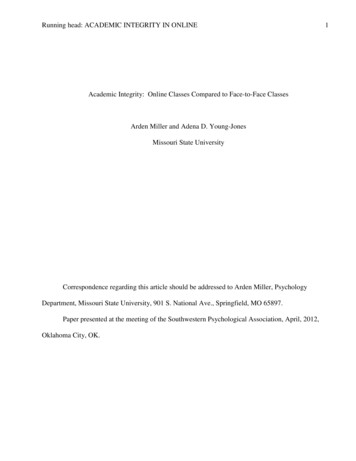
Transcription
Running head: ACADEMIC INTEGRITY IN ONLINEAcademic Integrity: Online Classes Compared to Face-to-Face ClassesArden Miller and Adena D. Young-JonesMissouri State UniversityCorrespondence regarding this article should be addressed to Arden Miller, PsychologyDepartment, Missouri State University, 901 S. National Ave., Springfield, MO 65897.Paper presented at the meeting of the Southwestern Psychological Association, April, 2012,Oklahoma City, OK.1
Running head: ACADEMIC INTEGRITY IN ONLINE2AbstractTrends toward an increase in online courses suggest the need for more research on differing levels ofcheating and other acts of academic disintegrity as compared to face-to-face classes. We surveyed 639students in both types of classes. Students felt it was easier to cheat in online classes than face-to-faceclasses. For students taking both online and face-to-face classes, we found that cheating occurred morefrequently in online classes. However, students who took only online classes were less likely to cheatthan students who took only face-to face classes. The relationship of age to taking online classes andcheating offered an explanation for the contradictory finding. Sex differences in cheating behavior wereabsent.
Running head: ACADEMIC INTEGRITY IN ONLINE3Academic Integrity: Online Classes Compared to Face-to-Face ClassesSince 2003, online enrollments have grown 358%, and 31% of students now take at least onecourse online (Allen & Seaman, 2011). But this research also shows that about a third of academicleaders perceive online outcomes to be inferior to traditional classes and that faculty members havemisgivings about online classes. These misgivings include lack of course comparability, moreopportunities to cheat in online classes, and a greater attraction to students whose goal is to cheat (Bailey& Bailey, 2011). Youngberg’s (2012) commentary in the Chronicle of Higher Education argues that thenumber one reason why online education will not replace college is “It’s too easy to cheat.” Themajority of faculty (64%) and students (57%) believe it is easier to cheat in online classes (Kennedy,2000).Despite this common belief, there is a lack of adequate research comparing academic disintegrityonline (OL) to face-to-face (FF) classes. Existing research has found higher levels of cheating in onlineclasses (Lanier, 2006). But others have found lower levels of cheating in online classes (Hart &Morgan, 2010; Kidwell & Kent, 2008, Stuber-McEwen, Wisely, & Hoggatt, 2009) or cheating levelscomparable to other research studies of FF classes (Grijalwa, 2006, Watson & Sottile, 2010). Butcomparing findings to other studies that estimate cheating in traditional classes, as Grijalwa did, is aweak methodology not suited to hypothesis testing.Research has found lower levels of cheating in online classes may have been subject to volunteerbiases that influence findings. In Hart’s (Hart & Morgan, 2010) study, the 44 participating studentsfrom traditional classes represented 44% of the cohort, while the 330 students from online classesrepresented only 16% of the cohort. Research shows that volunteerism is related to higher levels ofaltruism (Rosenthal & Rosnow, 1975), and thus may be selective for lower levels of cheating (Miller,Shoptaugh, & Parkerson, 2008). The online class cheating assessments, having lower response rates,
Running head: ACADEMIC INTEGRITY IN ONLINE4would be more significantly reduced by volunteer biases. Similarly, Kidwell and Kent (2008) had amuch higher response rate among traditional students (42%) relative to online students (24.8%).When comparing online students to traditional students, the glaring differences in attributes ofonline versus face-to-face students that are plausible explanations for any differences are often missed.Residential students are more likely to be in the 18-22 range, while non-traditional and older studentsare more likely to be enrolled in online classes. For example, Dutton, Dutton, and Perry (2002) foundthat the average age of their students in lecture classes was 22.5 as compared to the average age inonline classes of 27.6. Previous research has demonstrated that older students are less likely to cheat(Miller, Shoptaugh, & Parkerson, 2008). Past research has also indicated that, in general,undergraduates members of Greek social organizations tend to cheat more (Iyer & Eastman, 2006), andthese students are likely to be traditional, face-to-face students. A variety of other attributecharacteristics that may differ between online and face-to-face students could be determining factorsbehind the inconsistency of findings regarding cheating in online and face-to-face classes.What seems to be missing from these comparison studies is the fact that many students take bothsorts of classes. The benefit of surveying these students resides in the control of attribute differencesbetween online and traditional classes, making the students their own control. Our present research willconsider differences in cheating during online and face-to-face classes for students enrolled in both typesof classes. We will also consider between subject comparisons for students having only one type class.Additionally, we investigated whether there were differences in online and face-to-face student’sperceptions of how severe consequences should be and beliefs about the student’s responsibility toprevent cheating. Previous research has found students who cheat more believe consequences should beless severe (Kufahl, Shoptaugh, Miller, & Levesque, 2005) and demonstrate lower levels of AcademicIntegrity Responsibility (Miller, Shoptaugh, & Wooldrige, 2011). Academic Integrity Responsibility
Running head: ACADEMIC INTEGRITY IN ONLINE5(AIR) is the extent to which it is believed that students are responsible for deterrence of cheating incoursework. Low scores indicate the belief that promotion of academic integrity is primarily or solelythe responsibility of the teacher.The purpose of this study was to compare online course cheating to face-to-face course cheatingusing between subjects (students enrolled in only one type) and within subjects (students enrolled inboth online and face-to-face classes) comparisons, with an established survey (Miller, Shoptaugh, &Wooldridge, 2011). The survey has extra items added to accommodate differences in cheating thatoccur in an online class. Additionally, comparisons will be made on the AIR (Miller, et al., 2011).
Running head: ACADEMIC INTEGRITY IN ONLINE6MethodParticipantsParticipants were 531 undergraduates and 108 graduate students from two south-midwestuniversities. Extra credit was given as determined by their individual instructor. While 144 weresolicited through an introductory psychology pool at one university, 279 participants from the sameuniversity and 214 participants from the second university volunteered with varied incentives offered bytheir instructor. Students were sent to a web page that provided the consent form, with consentacknowledged by entering the survey web form. Median age was 22 with a range from 17 to 56 with67.5% of participants being female. We received 639 responses. Participants were fairly evenlydistributed across college class. Of these, 289 had both types of classes, 246 had only face-to-faceclasses, and 104 had only online classes.ProceduresAll items were completed in an html formatted web survey. At the outset it was made explicit thatall responses were entirely anonymous. The anonymous survey included 18 items to address categoriesof cheating with choices of: “never”, “once”, “more than once”, or “frequently”. With permission, theseitems were derived from McCabe’s surveys that have been widely used (McCabe & Trevino, 1993).However the items have evolved through two research studies (Miller, Shoptaugh, & Parkerson, 2008;Miller, Shoptaugh, & Wooldridge, 2011) and were updated to address both online and face-to-faceclasses, see Table 1. Participants also completed a five–item survey to assess Academic IntegrityResponsibility (AIR) (Miller, Shoptaugh, & Wooldridge, 2011). Students were asked how often theywitnessed cheating in the past year using the same choices as above and whether they thought it waseasier to cheat in online classes (1 strongly disagree, 5 strongly agree). Students also gave their sex,age, class, and GPA.
Running head: ACADEMIC INTEGRITY IN ONLINEAfter the anonymous survey was completed, students were taken to a new web form whichallowed them to enter their names into a second database in order to receive participation credit.7
Running head: ACADEMIC INTEGRITY IN ONLINE8ResultsFrequency of CheatingWhile 15.7% disagreed, 57.2% agreed that is easier to cheat in online classes. We analyzed theaccuracy of that belief in two ways. Within-subject comparisons were made with students having bothtypes of classes followed by between-subjects comparisons for students having only online (OL) or onlyface-to-face (FF) classes.Students taking both types of classes reported more cheating in OL classes, M 4.15 than in FFclasses, M 3.15, t (288) 4.35, p .001. The fact that these subjects took significantly more FFcredits, M 21.9, than OL credits, M 17.8, t (289) -6.73, p .001, demonstrates that cheatingfrequency findings cannot be explained by differences in number of credit hours completed. To thecontrary it raises the possibility that these differences could be underestimated.Secondly, we made between subject comparisons for students having only one type of class. Wefound lower rates of cheating in the only-OL students, M 2.52, than in only-FF students, M 4.66,t(265.4) -3.64, p .001. Number of hours were not significantly different, t(348) -1.85.Since the between subjects findings differed from within subjects findings, we explored the mostobvious attribute difference between online only and face-to-face only: age. Our introduction reviewedthe evidence that online students are older on the average and that older students cheat less. When agewas entered into the regression alone, the standardized regression coefficient was substantial, b* -.235,t(346) -4.51, p .001. When entering class type second in the regression, the effects the differencesbetween the two groups was no longer significant, b* .069, t(345) 1.16.Literature often describes cheating data in percentages who have cheated. Fewer OL only studentscheated, 51.9% than FF only students 71.5%, χ2(1) 12.49, p .001. This is likely due to the older ageof the OL only students. For students with both types of classes, we compared cheating within subjects
Running head: ACADEMIC INTEGRITY IN ONLINE9and found more students had cheated OL classes, 64.7%, than in FF classes, 49.1%, χ2(1) 14.3, p .001.An item by item view of differences for each type of cheating behavior in Table 1 shows howthese specific behaviors differ in OL and FF classes. In general there appears to be more unauthorizeduse of the crib notes, text, and web searches in online courses for students taking both types of classes.However, students in only face-to-face classes are more likely to use someone else’s work or provide itto another student, receive improper help in completing an assignment, get questions from those whohave taken the test and give questions to others, and misuse the internet relative to students who takeonly online classes.Differences in Online, Face-to-Face, and Students with BothTo conduct an analysis of variance comparing the three groups, a cheating score for students withboth types of classes was counted as their highest cheating rate for either the OL courses or the FFcourses. Significant findings were explored using Scheffe post hoc tests. Students in OL coursescheated less than others, F(2, 636) 5.90, p .01, see Table 2. Students taking OL classes were older,F(2, 633) 59.31, p .001 and witnessed less cheating in the past year, F(2, 636) 10.9, p .001.They were more inclined to take responsibility for the integrity environment, scoring higher onAcademic Integrity Responsibility (AIR), F(2, 635) 4.11, p .05. OL-only students were less likelyto believe that it is easy to cheat in OL than in FF classes, F(2, 628) 16.3, p .001.Sex DifferencesThere were no significant sex differences or interactions with sex for any measures of cheatingbehavior. Females scored higher on AIR, M 15.9 than males, M 14.73, t(634) -2.95.To consider arguments that differences in findings on sex often follow from differences inpopulations, we analyzed sex differences in cheating for each student source. While there was a non-
Running head: ACADEMIC INTEGRITY IN ONLINE10significant trend for males, M 5.33, to cheat more than females, M 3.95, in the population from thesecond university, t(212) 1.58, the opposite marginally significant trend, females cheating more, M 5.96 than males, M 3.95, was found among introductory psychology students at the first university,t(142) 1.68, p .10, with no such trends in the second population at the first university, t(277) .32.Other CorrelationsOlder students were less likely to cheat, more likely to take responsibility for academic integrity,perceived consequences should be more severe, and witnessed less cheating, see Table 3. This tableshows a variety of correlations relevant to understanding cheating in OL and FF classes. HigherAcademic Integrity Responsibility is related to a preference for more severe consequences, lesscheating, and less witnessing of cheating.
Running head: ACADEMIC INTEGRITY IN ONLINE11DiscussionWithin the academic community, it is commonly believed that cheating is more likely to occur inonline classes than face-to-face classes. Such pervasive notions exist despite a lack within the literatureto support this comparative idea. Our study builds on previous research, which has attempted to compareOL and FF cheating, by using a between subjects and within subjects design of participants taking bothtypes of classes (n 289), only FF (n 246), and only OL (n 104). While the overall consensusagreed that cheating is easier in online classes (57.2%), there is a level of complexity to this assertion.Specifically, our findings indicate that students taking both types of classes are more likely to cheat intheir online classes. However, a seemingly contradictory finding occurred when we considered studentswho only took OL or only FF classes, because students who took only OL classes cheated less thanother students. The findings showed that the population who take only online classes are older, takemore Academic Integrity Responsibility, and cheat less.The present research supports previous findings that cheating occurs within the academic setting.However, specific cheating behaviors differ for students taking both types of classes and only FFcourses. Students in both types of classes were significantly more likely to report the usage of cheatsheets during tests, paraphrasing without proper citation, assisting others cheat, and unauthorized use oftext or web in answering items. An overlap occurs for only FF students in helping someone else cheatand paraphrasing without appropriate citations. Additionally, only FF students are more likely to turn inwork done by someone else, complete work for someone else, give/receive inappropriate help, use afalse excuse, or submit previous work in subsequent classes.The pattern of correlations suggests that there is a culture or social component to cheating.Students who cheat more also witness more cheating and do not perceive they have any role in reducingcheating. This could suggest acceptance of cheating in many academic subcultures. Findings of higher
Running head: ACADEMIC INTEGRITY IN ONLINE12rates of cheating in fraternities and sororities supports the notion of disintegrity-accepting subcultures(Iyer & Eastman, 2006).While some studies report males cheat more than females, and a sex differences is often presumed,many studies, including this one, failed to find sex differences in cheating. Miller, et al. (2008) arguethat the differences in these findings occur primarily due to sex differences in volunteerism and as thesedifferences are very small and unreliable; sex should not be considered a significant factor in cheatingbehavior. The fact that three different sources for participants resulted in minimal but diverse sexdifferences underscores the weakness of any expectations about cheating behavior as a function of sex.While we found significant results in the present study, limitations exist regarding the nature ofsampling. Participants volunteered for extra credit points; individuals who desire extra credit may havedifferent characteristics than those who do not wish to participate. While using non-volunteers isethically problematic, varieties in incentive strength may influence the responding population (cf.,Miller et al, 2008). Additional research should also extend the understanding of disintegrity subculturesand explore methods to prevent such disintegrity. As there is an increasing trend toward online courses,extended research within this domain is necessary.An additional weakness resides in the selection of disintegity survey items. The morecomprehensive the survey, the higher the rates of cheating that are typically reported (Miller et al.,2008). If the survey were more comprehensive in covering forms of cheating common in one type ofclass than in another, this could generate significant differences in cheating rates. Particularly when weconsider differences in how students might cheat in an online class, attention must be paid tocomprehensive coverage in surveying disintegrity.It is common in the literature to report cheating as percentages of students who have cheated andwe included that statistic in our results. Although that is useful for comparing the results of different
Running head: ACADEMIC INTEGRITY IN ONLINE13studies, it can be misleading. If a treatment reduced students cheating from 12 times per semester to oneor two times per semester, it would not impact the percentage who have cheated. Yet treatments toprevent frequent cheating are probably more important than a treatment that affects a person who wouldcheat once. Unfortunately, a common metric, while desirable for discussions, is not very practical fortesting hypotheses.Regardless of teaching modality, educators should be aware that cheating occurs at rather highlevels. Overall, despite perpetual reminders that disintegrity is not acceptable, it is actually quitecommon within the academic setting. Deterrence of cheating in online classes requires attention to newstrategies that may be different from conventional classes. It appears that professors must be as, ormore, vigilant in addressing cheating in online classes.
Running head: ACADEMIC INTEGRITY IN ONLINE14ReferencesAllen, I., & Seaman, J. (2011). Going the Distance: Online Education in the USA 2011 Wellesley MA:Babson Survey Research GroupBailey, W. C., & Bailey, S. (2011). Do online and lecture students view cheating differently? Review ofBusiness Research, 11(5), 33-45.Dutton, J., Dutton, M., & Perry, J. (2002). How do online students differ from lecture students? Journalof Asynchronous Learning Networks, 6(1), 1-20.Grijalva, T. C., (2006). Academic honesty and online courses. College Student Journal, 40, 180-185.Hart, L., & Morgan, L. (2010) Academic Integrity in an online registered nurse to baccalaureate innursing program. Journal of Continuing Education in Nursing, 41, 498-505.Iyer, R. & Eastman, J. K. (2006). Academic dishonesty: Are business students different from othercollege students? Journal of Education for Business, 82(2), 101-110.Kennedy, K. (2000). Academic dishonesty and distance learning: Student and faculty views. CollegeStudent Journal, 34, 309-314.Kidwell, L. A. & Kent, J. (2008). Integrity at a distance: A study of academic misconduct amonguniversity students on and off campus. Accounting Education: An International Journal, 17,Supplement, S3-S16.Kufahl, L., Shoptaugh, C., Miller, A., & Levesque, C. (March, 2005). An evaluation of academichonesty attitudes, behaviors and correlates. Paper presented at the meeting of the SouthwesternPsychological Association, Memphis, TN.Lanier, M. M. (2006). Academic integrity and distance learning. Journal of Criminal Justice Education,17, 244-261.
Running head: ACADEMIC INTEGRITY IN ONLINE15McCabe, D. L., & Trevino, L. K. (1993). Academic dishonesty: Honor codes and other contextualinfluences. Journal of Higher Education, 64, 522-538.Miller, A.T., Shoptaugh, C, & Parkerson, A. (2008). Underreporting of cheating in research usingvolunteer college students. College Student Journal, 42, 326-339.Miller, A.T., Shoptaugh, C, & Wooldridge, J. (2011). Reasons not to cheat, academic-integrityresponsibility, and frequency of cheating. The Journal of Experimental Education, 79(2), 169184.Rosenthal, R., & Rosnow, R.L. (1975). The Volunteer Subject. New York: Wiley.Stuber-McEwen, D., Wiseley, P., & Hoggatt, S. (2009) Point, click, and cheat: frequency and type ofacademic dishonesty in the virtual classroom. Online Journal of Distance LearningAdministration, 12 (3), retrieved fromhttp://www.westga.edu/ distance/ojdla/fall123/stuber123.html.Watson, G. & Sottile, J. (2010) Cheating in the digital age: Do students cheat more in online courses?Online Journal of Distance Learning Administration, 13(1), retrieved fromhttp://www.westga.edu/ distance/ojdla/spring131/watson131.pdfYoungberg, D. (2012, August 13). Why online education won’t replace college—Yet. The Chronicle ofHigher Education, retrieved from ont/133531/?cid wc&utm source wc&utm medium en.
Running head: ACADEMIC INTEGRITY IN ONLINE16Table 1Individual cheating item (1 never) differences within students having both types of classes andbetween groups for students with only one type of class.1. Turning in work done by someone else.2. UNauthorized use of the text or other book in answering items on atest, quiz, or other assessment.3. UNauthorized use of a web search or other digital media inanswering items on a test, quiz, or other assessment.4. Writing or providing a paper or assignment for another student.5. Receiving help on an assignment that exceeds that which would beacceptable to the teacher.6. Getting questions or answers from someone who has already taken atest.7. Providing questions or answers to a student who will be taking thetest at a later time.8. Helping someone else cheat during a quiz or exam.9. Copying or getting help from another student during a quiz or exam.10. Paraphrasing (copying with rewording) a sentence from a written orinternet source without footnoting or referencing it in the paper.11. Copying a sentence directly from a written or internet sourcewithout quotes and proper referencing.12. Turning in a paper obtained in large part from a term paper "mill"or website.13. Using unpermitted crib notes (or cheat sheets) during a test.14. Altering a graded test and submitting it (as misgraded) for extracredit.15. Turning in a paper copied, at least in part, from another student'spaper.16. Using a false excuse to obtain an extension on a due date or to takea test at a different time.17. Participating in the exchange or sharing of a stolen copy of the test.18. Turning in a paper that you originally wrote for another classwithout awareness of the professor regarding its previous use.* p .01 two tailedBoth TypesOne 091.141.161.04*1.20
Running head: ACADEMIC INTEGRITY IN ONLINE17Table 2Differences in online only, face-to-face only, and student with both types of classesOnline(N 104)Class TypeFace-to-Face(N 246)Both(N 289)M (SD)M (SD)M (SD)Self-reported Cheating *2.52 (4.45)a4.66 (6.18)b4.81 (6.44)bAge **28.8(7.90) a21.2(5.36) b23.65(5.65) cAIR (p .05)16.6(4.84) a15.1(4.44) b15.44(4.40) a bOnline Cheating is easier **3.08(1.31) a3.88(1.13) b3.72(1.20) bWitnessed cheating**1.74(1.06) a2.29(1.11) b* Difference significant at the p .01 level** Difference significant at the p .001 levelabcMeans with the same letter do not differ on Scheffe test1.99(1.03) bVariable
Running head: ACADEMIC INTEGRITY IN ONLINE18Table 3Correlations between selected variablesAIR23465-.0831. AIR--.275*.369*-.339*-.116*0.0582. Cheating--.276*.376*.150*0.0183. Consequence--.137*0-0.0624. Witnessed-.198*-0.0775. OL cheating easier-6. GPA* p .01
majority of faculty (64%) and students (57%) believe it is easier to cheat in online classes (Kennedy, 2000). Despite this common belief, there is a lack of adequate research comparing academic disintegrity online (OL) to face-to-face (FF) classes. Existing research has found higher levels of cheating in online classes (Lanier, 2006). But .
